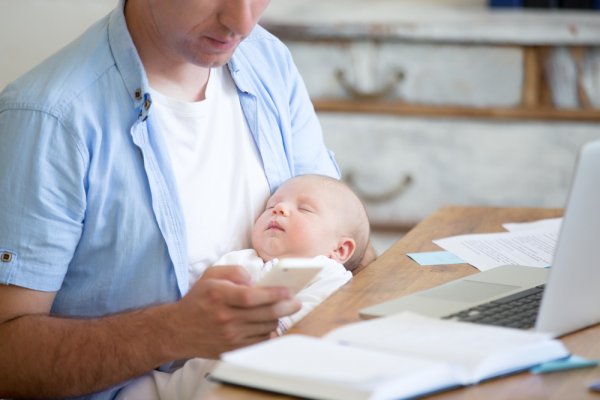The United States and Australia were famously slow to guarantee new parents paid time off from work. The Australian national paid parental leave policy wasn’t enacted until 2009, and it is relatively modest compared to other developed countries. And the US still (shockingly!) lacks a national law, although a growing number of American states have enacted paid leave policies.
But in some ways, both countries are also leaders. Virtually every other country in the world explicitly prioritises maternity leave over paternity leave. Australia’s national policy, and the US state laws, by contrast, do not use sex-based classifications. That said, as I discuss more fully in a forthcoming paper, simply labeling both as gender neutral obscures fundamental structural differences.
 Australia provides 18 weeks of benefits for primary caregivers and just two weeks of benefits for secondary caregivers; parents also have a right to a year of unpaid leave. In the US, by contrast, mothers and fathers each generally receive 12 weeks of leave. I’m an expert on US leave laws, and I was curious about these different approaches. So, with the support of a grant from the Fulbright Commission, I came to Australia to learn more about the Australian system.
Australia provides 18 weeks of benefits for primary caregivers and just two weeks of benefits for secondary caregivers; parents also have a right to a year of unpaid leave. In the US, by contrast, mothers and fathers each generally receive 12 weeks of leave. I’m an expert on US leave laws, and I was curious about these different approaches. So, with the support of a grant from the Fulbright Commission, I came to Australia to learn more about the Australian system.
Maternity Leave Taking
In Australia, most new mothers take between six months and one year off work, with fathers typically taking much shorter leaves. Talking to experts (and non-experts) in Australia brought home to me how societally informed our sense of how long leave should be. Most of the people I interviewed thought new mothers needed at least six months to physically recover from pregnancy and childbirth, bond and care for a new baby, and facilitate breastfeeding. Many thought a year was ideal. That said, some suggested that the norm of a year was too long and that it contributes to women’s disengagement from work or the frequency with which women are made redundant during maternity leaves.
 In the US, most women take far less time off. Since there’s no federal right to paid leave, low-wage workers are often back on the job within just a few weeks. Even more highly-paid workers typically take just three or four months. And, strikingly, most say they are satisfied. In a large poll of new mothers, 72% of mothers said they had stayed home as long as they wanted to; this was true even though about half of the mothers were back at work within three months or less. When the pollsters explained that most countries provide longer paid maternity leaves, US moms indicated a preference for, on average, a six or seven-month leave, but some continued to say three months was optimal whereas others said a year or more would be optimal.
In the US, most women take far less time off. Since there’s no federal right to paid leave, low-wage workers are often back on the job within just a few weeks. Even more highly-paid workers typically take just three or four months. And, strikingly, most say they are satisfied. In a large poll of new mothers, 72% of mothers said they had stayed home as long as they wanted to; this was true even though about half of the mothers were back at work within three months or less. When the pollsters explained that most countries provide longer paid maternity leaves, US moms indicated a preference for, on average, a six or seven-month leave, but some continued to say three months was optimal whereas others said a year or more would be optimal.
“Equality’s Riddle”
Laws shape such leave patterns – and are shaped by them. In fact, questions regarding how infant care should be allocated between parents, and how leave policy interacts with women’s participation in the paid workforce, implicate fundamental questions of sex discrimination doctrine and theory, famously characterised by American law professor and advocate Wendy Williams as “equality’s riddle”.
Advocates suggest that sex-specific maternity leaves reify assumptions that women will provide the bulk of childcare, and may spur workplace discrimination against new mothers.
Given biological differences between women and men, and gender norms around infant care, some theorists and advocates suggest women’s equality is best served by providing a relatively lengthy maternity leave. Without this, they suggest, women will simply drop out of the workforce entirely. Other theorists and advocates suggest that sex-specific maternity leaves reify assumptions that women will provide the bulk of childcare, and may spur workplace discrimination against new mothers. Australian policy generally reflects the first approach, and US policy reflects the second.
Australia: Historical Supports Specifically for Mothers
Australia’s maternity leave regime dates back to a 1979 test case, which resulted in a labor standard that required employers to provide new mothers 12 months of unpaid leave, with six weeks being mandatory. The federal Sex Discrimination Act, enacted in 1984, specifically permits women to receive benefits connected to pregnancy, childbirth, and breastfeeding that are not provided to men.
 In a later case, men tried to argue that the maternity leave regime was illegal sex discrimination, as well as that it was bad policy. They lost. The Industrial Relations Commission took the position that differential treatment may be required to promote equal opportunity, a concept often known as substantive equality: “It is our view that under certain conditions discrimination can arise by purporting to treat equally persons whose circumstances are materially different.”
In a later case, men tried to argue that the maternity leave regime was illegal sex discrimination, as well as that it was bad policy. They lost. The Industrial Relations Commission took the position that differential treatment may be required to promote equal opportunity, a concept often known as substantive equality: “It is our view that under certain conditions discrimination can arise by purporting to treat equally persons whose circumstances are materially different.”
Even now that Australia’s leave regimes are nominally gender neutral, they prioritise benefits and leave for a primary caregiver, and offer much less support for secondary caregivers. (For more detail on this, see my earlier Broad Agenda blog post.)
US: Equal Treatment of Mothers and Fathers
The US history is quite different. Sex discrimination in employment was prohibited in 1964, long before the country had enacted any leave rights. Courts and the federal equal employment agency interpret that law to require that men and women receive equal amounts of parental leave time, other than a relatively short period (generally 6-8 weeks) when women are considered to be physically recovering from child birth. Accordingly, the federal law that provides unpaid leave rights, and more recent state laws providing paid leave, provide equal and individual benefits to each parent, without any distinction between primary and secondary caregivers.
This has some important benefits. As I discuss in a forthcoming study, early evidence suggests it’s effective at encouraging men to take time off. But it also has some real downsides. The overall length of leave in the US remains quite limited, and it shortchanges single parents who receive half as much leave.
Ultimately, I would say the jury is still out on equality’s riddle. Both countries have made important progress, and both have more to do on supporting mothers and fathers as workers and parents.




